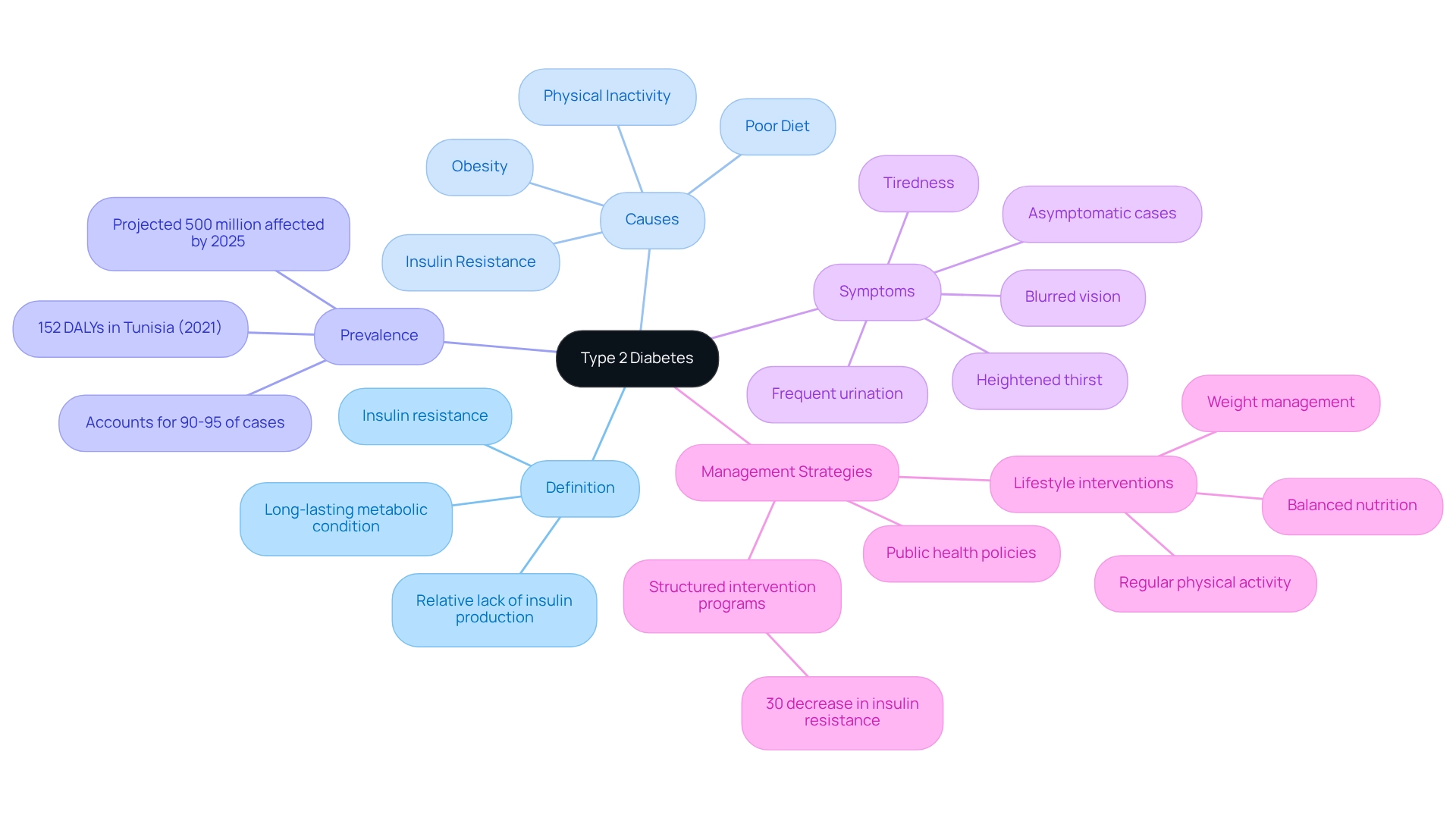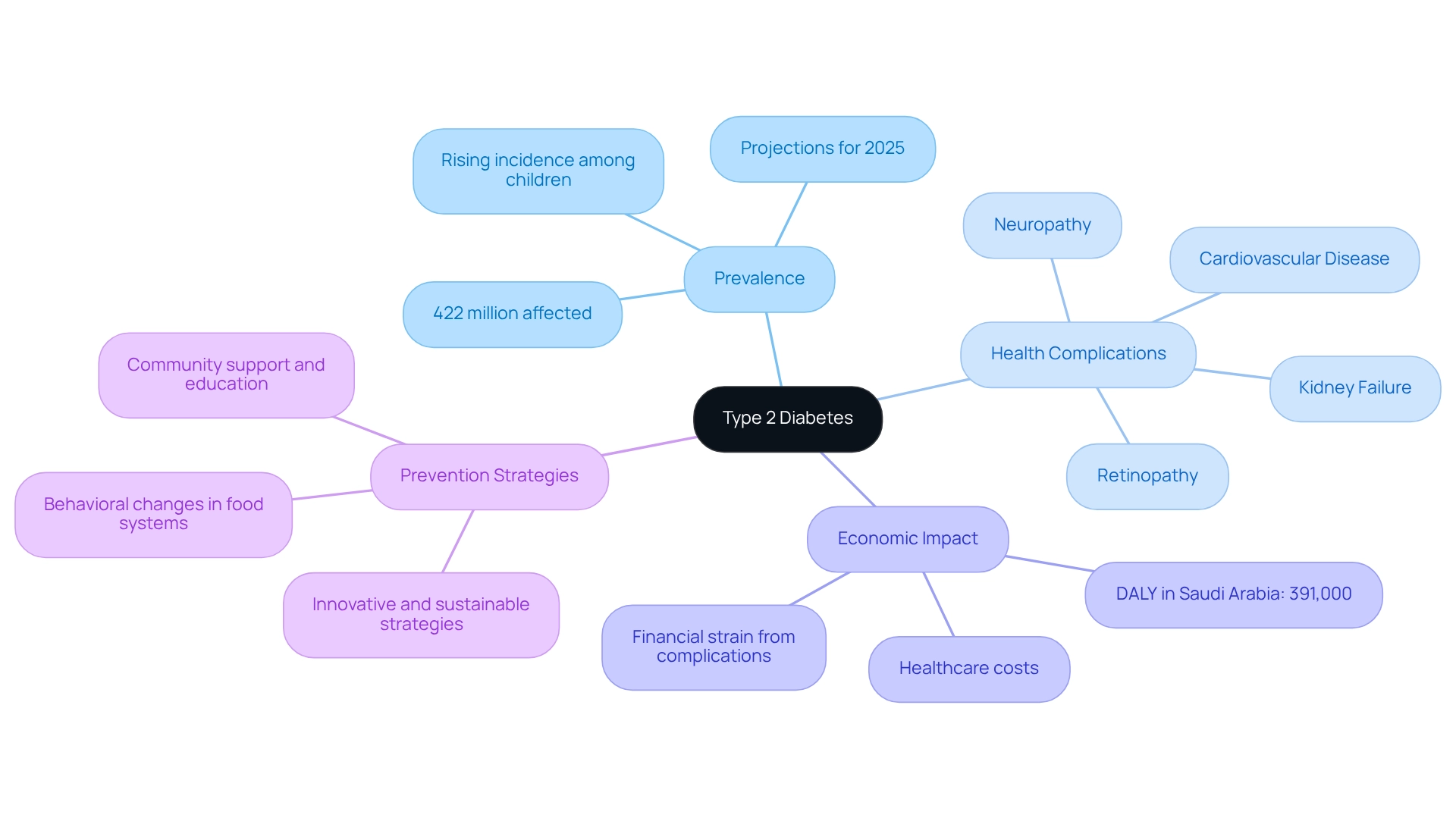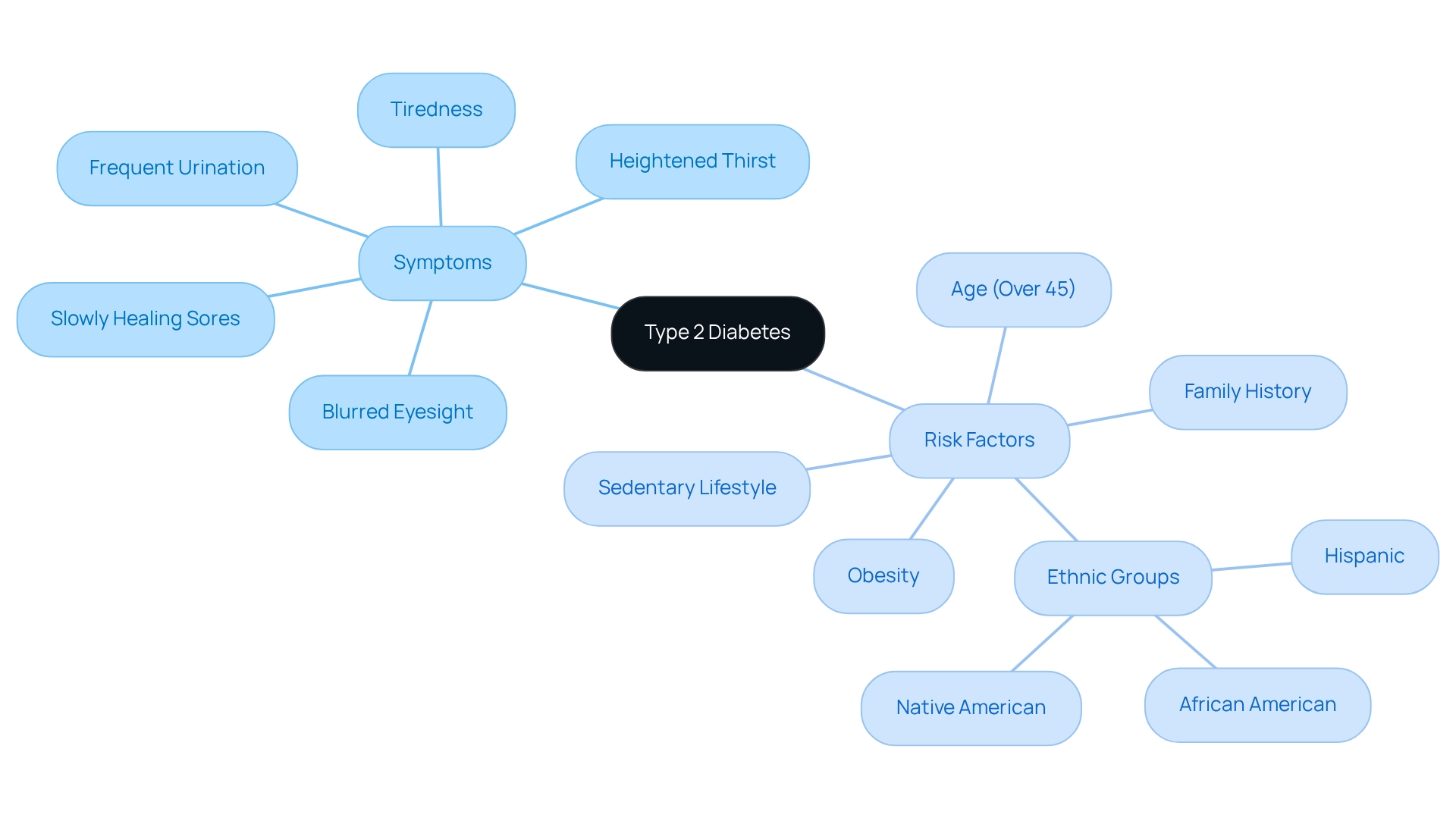Overview
Type 2 diabetes is a long-lasting metabolic condition that can feel overwhelming. It is characterized by insulin resistance and a relative lack of insulin production, which leads to elevated blood glucose levels. You're not alone in navigating this condition, which accounts for 90-95% of diabetes cases globally. It’s closely linked to lifestyle factors, and understanding this connection is vital for managing your health.
This condition poses significant health risks, and it’s understandable to feel concerned about its implications. The good news is that there are effective management and prevention strategies available. By focusing on lifestyle changes and seeking support, you can take control of your health journey. Remember, we are here to support you every step of the way.
Introduction
In a world increasingly burdened by chronic health conditions, Type 2 Diabetes emerges as a significant and growing concern. This condition, defined by insulin resistance and a range of lifestyle-related risk factors, affects millions globally. It's projected that over 500 million individuals could be impacted by 2025. The implications of Type 2 Diabetes extend beyond individual health, posing serious economic challenges and escalating healthcare costs.
As awareness of Type 2 Diabetes rises, it’s crucial to understand its origins, symptoms, and effective management strategies. By examining the multifaceted nature of this disease, individuals can navigate their health journeys with greater confidence. Remember, you’re not alone in this journey; communities can develop targeted interventions to combat this escalating epidemic. Together, we can foster understanding and support for those affected.
Define Type 2 Diabetes: Understanding the Condition
What is the definition of type 2 diabetes? It is a long-lasting metabolic condition characterized by insulin resistance. This means that the body's cells do not react properly to insulin, along with a relative lack of insulin production. As a result, this dysfunction leads to elevated blood glucose levels, known as hyperglycemia. Unlike Type 1 diabetes, which primarily involves an autoimmune response that destroys insulin-producing beta cells in the pancreas, Type 2 typically develops gradually. It is often closely linked to lifestyle factors such as obesity, physical inactivity, and poor dietary habits.
Globally, Type 2 diabetes accounts for approximately 90-95% of all cases, and its prevalence continues to rise despite increased awareness of its drivers. Recent studies suggest that by 2025, over 500 million people worldwide may be affected by this condition, underscoring the critical need for effective management approaches. For instance, in Tunisia, there were 152 Disability-Adjusted Life Years (DALYs) associated with this health condition in 2021, highlighting the considerable burden in specific areas.
Insulin resistance is a crucial aspect of Type 2 diabetes, and understanding its implications for treatment is vital. Endocrinologists emphasize that addressing insulin resistance through lifestyle interventions—such as regular physical activity, balanced nutrition, and weight management—can significantly improve glycemic control. For example, a structured lifestyle intervention program resulted in a 30% decrease in insulin resistance among participants. This highlights the potential for practical applications in managing the condition.
Awoke Misganaw Temesgen observed the global, regional, and national burden of the disease from 1990 to 2021, with forecasts suggesting that this burden will continue to increase until 2050. This emphasizes the importance of applying strategies to alleviate the burden of this condition and its effects on other health issues.
Symptoms of Type 2 diabetes can include heightened thirst, frequent urination, tiredness, and blurred vision. However, many individuals may remain asymptomatic for years. This emphasizes the necessity of regular screening, especially for those who need to understand what is the definition of type 2 diabetes. It's understandable to feel overwhelmed by this information, but remember, you're not alone in this journey. In conclusion, when considering what is the definition of type 2 diabetes, it is evident that it is a complex condition that demands a multifaceted approach to care. This includes both medical and lifestyle strategies to improve patient outcomes and quality of life. The insights from data-driven research further support the creation of effective public health policies and healthcare initiatives for blood sugar regulation. For those newly diagnosed, T2DSolutions offers valuable resources and community support to help navigate this condition. We encourage you to explore T2DSolutions for additional details on blood sugar control strategies. Remember, we are here to support you every step of the way.

Context and Importance: The Impact of Type 2 Diabetes
The rise of Type 2 Diabetes, which raises the question of what is the definition of type 2 diabetes, has become a global epidemic, affecting over 422 million individuals as reported by the World Health Organization in 2014, and this number continues to rise. By 2025, we expect a significant increase in prevalence, largely due to rising obesity rates and lifestyle changes. This condition is not just a statistic; it is linked to serious health complications such as:
- cardiovascular disease
- kidney failure
- neuropathy
- retinopathy, potentially leading to blindness.
The economic implications are profound; healthcare costs associated with blood sugar disorders and their complications put immense pressure on public health systems worldwide. In Saudi Arabia, for instance, the disability-adjusted life years (DALY) attributed to this condition reached 391,000, underscoring the urgent need for effective management strategies. Sir Zumla, a UK-NIHR Senior Investigator, highlights that "the economic burden of diabetes is staggering, necessitating immediate and coordinated action to alleviate its impact on healthcare systems."
The rising incidence of Type 2 Diabetes among children and adolescents is particularly alarming, emphasizing the importance of understanding what is the definition of type 2 diabetes, which calls for immediate action through education and prevention efforts. A recent report titled "Future Directions for Diabetes Prevention" stresses the importance of innovative and sustainable strategies that promote behavioral and structural changes within food systems and lifestyle choices. This coordinated global initiative is vital to lessening the escalating burden of diabetes-related issues and improving health outcomes.
Real-life stories shed light on the complications stemming from unmanaged diabetes, with many individuals facing debilitating effects that greatly reduce their quality of life. The financial strain of the second form of diabetes is further intensified by the costs associated with treating these complications, emphasizing the importance of early intervention and comprehensive management strategies. As the prevalence of Type 2 Diabetes continues to grow, it becomes increasingly critical to understand what is the definition of type 2 diabetes and address these challenges through informed strategies and community support. Remember, you're not alone in this journey; there are resources and support systems available to help you every step of the way.

Origins and Evolution: The History of Type 2 Diabetes
The history of this condition can be traced back to ancient civilizations, with the term originating from the Greek word for 'siphon,' aptly describing the frequent urination characteristic of the ailment. In the early 20th century, form 2 of this condition emerged as a unique variety, initially referred to as 'adult-onset condition,' which leads to the question: what is the definition of type 2 diabetes, as it primarily affected older individuals? However, as obesity rates surged and lifestyle changes became more common, the landscape began to shift dramatically. This resulted in a notable decrease in the age of onset and prompted a reclassification of the condition.
The groundbreaking discovery of insulin in 1921 marked a pivotal moment in treatment for blood sugar disorders. Yet, it wasn't until the late 20th century that the focus expanded to include lifestyle interventions and the control of insulin resistance as essential components of what is the definition of type 2 diabetes. This evolution in understanding has been vital, especially as research shows a rising occurrence of blood sugar disorders, leading to questions like what is the definition of type 2 diabetes among younger populations. It emphasizes the necessity for comprehensive strategies that address both medical and lifestyle factors, while historical case studies illustrate what is the definition of type 2 diabetes through the changing demographics and the significant increases in prevalence observed globally. For instance, in Iran, the prevalence reached 7,000 cases per 100,000 in 2017, reflecting a broader trend that highlights the urgent need for effective solutions in addressing health conditions related to blood sugar. Furthermore, with over 34 million individuals in the U.S. diagnosed with this condition, understanding what is the definition of type 2 diabetes is essential, as its increasing prevalence poses a substantial burden on healthcare systems globally. This is underscored in the case study titled 'The Growing Burden of Diabetes on Healthcare Systems.' Tackling the challenges of blood sugar control is crucial for enhancing health results and minimizing the financial burden on healthcare systems.
As our understanding of such conditions continues to advance, it becomes clear that addressing the intricacies of this issue is essential for improving health outcomes and easing the strain on healthcare systems globally. T2DSolutions is committed to providing comprehensive resources and community support for individuals who want to learn what is the definition of type 2 diabetes. We encourage you to subscribe to our updates to remain informed about new content and resources that can assist in your health journey. As Abid Haleem mentioned, 'This disruptive technology would facilitate the supervision of discharged patients and oversee their recovery,' emphasizing the significance of innovative solutions in managing the condition. Remember, you're not alone in this journey; we are here to support you every step of the way.

Key Characteristics: Symptoms and Risk Factors of Type 2 Diabetes
Common symptoms of the second type of diabetes can include heightened thirst, frequent urination, tiredness, blurred eyesight, and slowly healing sores. It's important to note that many individuals may not show significant symptoms in the early stages, which can lead to delays in diagnosis and treatment. As we look ahead to 2025, the occurrence of this condition continues to rise, with an annual increase of 4.8%. This highlights the critical need for awareness and early detection.
Key risk factors for developing this condition include:
- Obesity
- A sedentary lifestyle
- Family history of the illness
- Age, particularly for those over 45
Certain ethnic groups, including African American, Hispanic, and Native American populations, are also at a higher risk. Understanding these risk factors is crucial for seeking timely medical advice and making informed lifestyle changes that can significantly reduce your risk.
Healthcare experts emphasize the importance of recognizing symptoms early and managing risk factors effectively. Proactive lifestyle changes, such as maintaining a healthy weight and engaging in regular exercise, can truly make a difference in reducing the risk of developing what is the definition of type 2 diabetes. The American Diabetes Association highlights that 28 percent of medical expenses related to the illness are for nervous system disorders, illustrating the broader impact of this condition on healthcare costs.
Real-world examples show how effective risk factor management can lead to positive health outcomes. For instance, consider the inspiring story of a patient who lost weight through a community-supported exercise program. This case demonstrates how embracing healthier habits can result in significant improvements in one's health, and by fostering awareness of what is the definition of type 2 diabetes, T2DSolutions aims to empower you to take charge of your health. Seeking timely medical intervention and implementing preventive measures can lead to an improved quality of life. Community engagement is vital in this journey, as support from peers can encourage you to maintain healthy habits and stay informed about your condition. T2DSolutions is here to provide resources and support, helping you understand and manage these symptoms and risk factors effectively. Remember, you're not alone in this journey; we are here to support you every step of the way.

Conclusion
Type 2 Diabetes is not merely a personal health issue; it embodies a growing global epidemic with significant implications for individuals and healthcare systems alike. This complex condition is primarily characterized by insulin resistance and a gradual onset, often worsened by lifestyle factors such as obesity and inactivity. Understanding the origins, symptoms, and risk factors associated with Type 2 Diabetes is essential for effective management and prevention. It's important to recognize that early detection and proactive lifestyle changes can greatly improve outcomes and reduce the risk of severe complications.
The economic burden of Type 2 Diabetes is staggering, impacting healthcare systems worldwide and necessitating immediate action. Projections indicate that millions more will be affected in the coming years, underscoring the urgency for comprehensive strategies to address this crisis. Community support and targeted interventions play a vital role in empowering individuals to take charge of their health. Together, we can foster a collective effort to combat this escalating epidemic.
Ultimately, awareness and education are key to navigating the complexities of Type 2 Diabetes. By leveraging resources such as T2DSolutions, individuals can find the necessary support to manage their condition effectively. Remember, you're not alone in this journey. Together, through informed strategies and community engagement, it is possible to mitigate the impact of Type 2 Diabetes and enhance the quality of life for millions affected by this condition.
Frequently Asked Questions
What is the definition of type 2 diabetes?
Type 2 diabetes is a long-lasting metabolic condition characterized by insulin resistance, where the body's cells do not respond properly to insulin, along with a relative lack of insulin production, leading to elevated blood glucose levels, known as hyperglycemia.
How does type 2 diabetes differ from type 1 diabetes?
Unlike Type 1 diabetes, which is primarily an autoimmune response that destroys insulin-producing beta cells in the pancreas, Type 2 diabetes typically develops gradually and is often linked to lifestyle factors such as obesity, physical inactivity, and poor dietary habits.
What is the global prevalence of type 2 diabetes?
Type 2 diabetes accounts for approximately 90-95% of all diabetes cases worldwide, with forecasts suggesting that over 500 million people may be affected by the condition by 2025.
What are the common symptoms of type 2 diabetes?
Common symptoms include heightened thirst, frequent urination, tiredness, and blurred vision. However, many individuals may remain asymptomatic for years.
Why is insulin resistance important in type 2 diabetes?
Insulin resistance is a crucial aspect of Type 2 diabetes, and addressing it through lifestyle interventions like physical activity, balanced nutrition, and weight management can significantly improve glycemic control.
What lifestyle interventions can help manage type 2 diabetes?
Regular physical activity, balanced nutrition, and weight management are effective lifestyle interventions that can improve glycemic control and reduce insulin resistance.
What is the significance of regular screening for type 2 diabetes?
Regular screening is essential, especially for those who may be at risk, as many individuals can remain asymptomatic for years, making it important to identify the condition early.
What resources are available for those newly diagnosed with type 2 diabetes?
T2DSolutions offers valuable resources and community support to help individuals navigate the condition and improve blood sugar control strategies.



